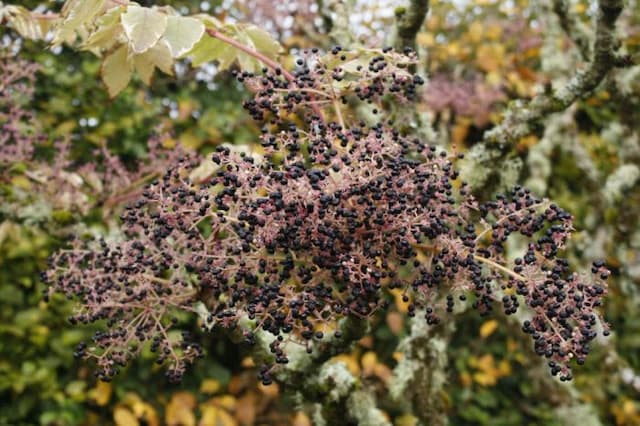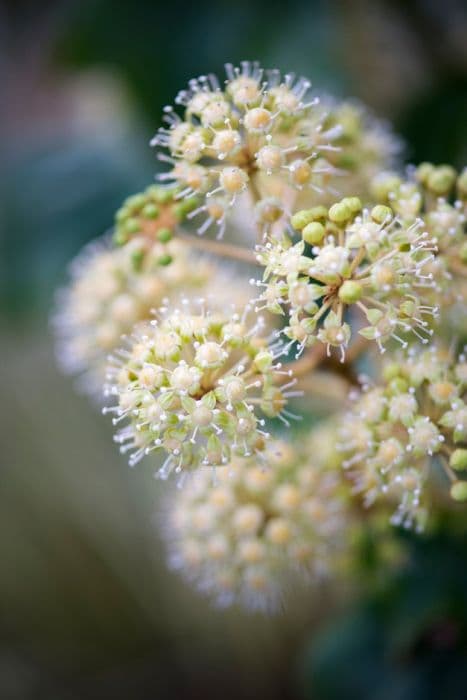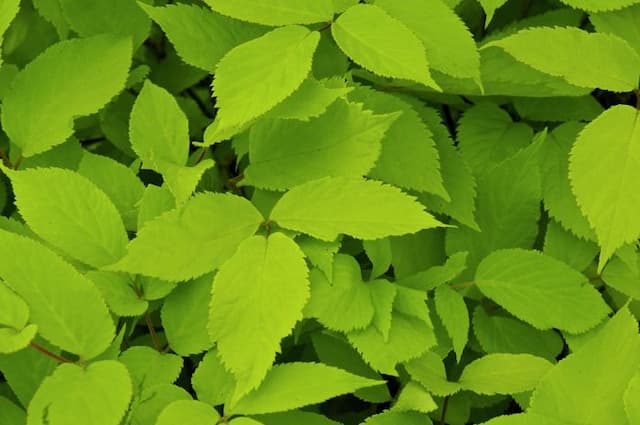English Ivy Hedera helix 'Parsley Crested'

ABOUT
The English Ivy plant known as 'Parsley Crested' is distinguished by its unique and ornamental foliage. The leaves of this variegated cultivar present a crinkled or ruffled texture that resembles the appearance of parsley, which is where it gets its name. Each leaf boasts a deep green color with light veining, and the edges are often irregular, giving the plant a luxuriant and dense appearance. The 'Parsley Crested' English Ivy has a trailing or climbing habit, typically clinging to surfaces with its aerial rootlets, and can spread quite beautifully when allowed. Whether used as a hanging plant or as groundcover, 'Parsley Crested' stands out due to the distinct shape and texture of its leaves. In some cases, the leaves may exhibit a slight glossiness, adding to its visual appeal. It's an attractive choice for gardeners looking to add texture and visual interest to their plant collections without the height and width dimensions being their primary concern. The plant is adaptable to a variety of growing conditions although it thrives best in partially shaded areas. This English ivy variant is a versatile and decorative plant that enlivens indoor spaces or gardens with its intricate and lush foliage.
About this plant
 Names
NamesFamily
Araliaceae.
Synonyms
English Ivy, Common Ivy, European Ivy, Ivy.
Common names
Hedera helix 'Cristata', Hedera helix 'Crispa', Hedera helix 'Ivalace'
 Toxicity
ToxicityTo humans
English Ivy, which includes the cultivar 'Parsley Crested', is considered toxic if ingested. Its leaves and berries contain compounds such as saponins, which can cause various symptoms if consumed. Symptoms of English Ivy poisoning may include abdominal pain, vomiting, and diarrhea. In some cases, consuming large quantities can result in more severe symptoms such as difficulty breathing, fever, polydipsia (excessive thirst), ataxia (lack of muscle coordination), or even coma. It is important to avoid ingesting any part of the plant and to keep it out of reach of children.
To pets
English Ivy is also toxic to pets, including cats and dogs. The symptoms of toxicity in pets are similar to those in humans. If your pet consumes English Ivy, they may experience vomiting, abdominal pain, hypersalivation, and diarrhea. In severe cases, ingestion can lead to more serious conditions such as coma or respiratory failure. It is essential to ensure that your pets do not chew on or consume any part of this plant, and to seek veterinary care immediately if you suspect your pet has ingested English Ivy.
 Characteristics
CharacteristicsLife cycle
Perennials
Foliage type
Evergreen
Color of leaves
Green
Height
6-9 feet (1.8-2.7 meters)
Spread
6-9 feet (1.8-2.7 meters)
Plant type
Climber
Hardiness zones
5-11
Native area
Europe
Benefits
 General Benefits
General Benefits- Aesthetic appeal: The plant features unique, crinkled and crested leaves that can add a visually interesting texture to gardens or indoor spaces.
- Versatility in landscaping: It can be used for ground cover, to climb structures, or in hanging baskets, adapting well to various garden designs.
- Low maintenance: It is known for being hardy and requires minimal care once established, making it suitable for gardeners of all skill levels.
- Shade tolerance: Thrives in shaded areas where other plants might struggle, making it ideal for spots that receive limited sunlight.
- Drought tolerance: Once established, it has good resistance to drought, reducing the need for frequent watering.
- Cold hardy: It can tolerate cold temperatures and is capable of surviving in lower temperatures than many other plants.
- Fast growth: Has a rapid growth rate which makes it effective for quickly covering unsightly areas or creating privacy screens.
- Erosion control: Its dense foliage and root system can help prevent soil erosion on slopes and in other vulnerable areas.
- Evergreen: As an evergreen plant, it provides year-round color and interest in the landscape.
- Habitat support: It can offer shelter and sometimes food to a variety of wildlife, including birds and insects.
 Medical Properties
Medical Properties- Expectorant: English ivy, the common name for Hedera helix, has been traditionally used to help relieve coughs and bronchitis.
- Anti-inflammatory: It is thought to have anti-inflammatory properties which may assist in reducing swelling in the airways.
- Antispasmodic: English ivy may help to relieve muscle spasms, a property that could be beneficial in treating coughs.
- Antimicrobial: Some studies suggest that compounds in English ivy have antimicrobial properties.
- Antioxidant: English ivy leaves contain flavonoids and other polyphenolic compounds that can act as antioxidants.
 Air-purifying Qualities
Air-purifying QualitiesThis plant is not specifically known for air purifying qualities.
 Other Uses
Other Uses- Textile Prints: The distinctive leaf shape of English Ivy can be used in textile design to create natural patterns in fabrics, through processes like leaf pounding or eco-printing.
- Natural Insect Repellant: The sap of English Ivy, when applied carefully, can work as a barrier to keep certain insects away, due to its potentially irritating properties to some pests.
- Photography Backdrops: Dense mats of English Ivy can serve as lush, green backdrops for photographers looking for a natural and textured background in their compositions.
- Craft Material: Dried stems and vines of English Ivy can be woven into wreaths, baskets, or other creative craft items, offering a rustic charm.
- Environmental Education: English Ivy can be used in school projects or educational programs to demonstrate invasive species management and the importance of native plant conservation.
- Landscape Design: Variegated varieties of English Ivy add visual interest and contrast when used in ornamental garden designs, hedges, or as companion plants in container gardening.
- Topiary Art: English Ivy is flexible and can be trained over wireframes to create living sculptures in gardens and parks, known as topiaries.
- Natural Dyes: The leaves of English Ivy can be boiled to extract natural dyes for coloring fabrics or crafting inks.
- Culinary Presentations: Although the plant is not edible, English Ivy leaves can be used as decorations on food platters or as natural garnishes for culinary display, with caution to avoid ingestion.
- Mood Enhancements: Being amidst English Ivy can have a calming effect, making it suitable for use in spaces designed for relaxation such as spas, retreats, or meditation areas.
Interesting Facts
 Feng Shui
Feng ShuiThe English Ivy is not used in Feng Shui practice.
 Plant Symbolism
Plant Symbolism- Connection and Unity: English Ivy symbolizes connection and unity due to its growth pattern. The way it clings to and weaves through structures serves as a metaphor for the interconnectedness of all things.
- Eternal Life: Due to its perennial nature and evergreen qualities, English Ivy is often seen as a representation of eternal life and the immortal soul.
- Fidelity and Friendship: Its clinging characteristic also suggests fidelity and attachment, making it a symbol of lasting friendship and loyalty.
- Protection: Often associated with ivy-covered walls of old buildings, English Ivy is thought to symbolize protection, as it creates a natural barrier.
- Survival and Resilience: English Ivy's ability to thrive in challenging conditions signifies resilience and the will to survive against the odds.
- Prosperity: In some cultures, English Ivy is believed to bring prosperity and good fortune, particularly when it grows vigorously on or around a person's home.
 Water
WaterFor the English Ivy, or Hedera helix 'Parsley Crested', it's essential to maintain consistently moist soil without overwatering. Water the plant thoroughly when the top inch of soil feels dry to the touch, which generally means watering once every 7 to 10 days. Depending on the size of the pot and the environmental conditions, you might need about 16 to 32 onzes per watering session. During the winter months, reduce the frequency as the plant's growth slows down. Be sure to allow excess water to drain away to prevent root rot.
 Light
LightEnglish Ivy prefers bright, indirect light to thrive but can also adapt to medium light. Avoid placing your English Ivy in direct sunlight, which can scorch the leaves, opting instead for a spot near a window with filtered light. A north or east-facing window is typically a good location, providing the ideal light conditions without exposing the plant to harsh midday sun.
 Temperature
TemperatureEnglish Ivy grows best in temperatures between 50°F to 70°F and can handle a minimum of 30°F to a maximum of 80°F. Avoid placing your English Ivy near drafts, heating or cooling vents, as extreme shifts in temperature can stress the plant. The ideal conditions are a consistently cool to moderate temperature range without drastic fluctuations.
 Pruning
PruningPruning English Ivy is necessary to maintain its shape, encourage bushier growth, and remove any dead or damaged leaves. The best time to prune is in the spring or summer when the plant is actively growing. Light pruning can be done year-round as needed. Shape the plant by cutting just above a leaf to encourage the plant to branch out, and remove any undesired or long trails to keep the Ivy looking its best.
 Cleaning
CleaningAs needed
 Soil
SoilEnglish Ivy 'Parsley Crested' thrives in well-draining, loamy soil with a pH between 6.0-7.5. A suitable mix can be made with equal parts potting soil, peat and perlite to ensure good drainage and aeration. Regular testing and amending of the soil will help maintain the desired pH.
 Repotting
RepottingEnglish Ivy 'Parsley Crested' should be repotted every two years to refresh the soil and accommodate root growth. If the plant is experiencing rapid growth or becomes root-bound, increase the frequency of repotting accordingly.
 Humidity & Misting
Humidity & MistingEnglish Ivy 'Parsley Crested' prefers high humidity levels, ideally between 40% to 60%. Mist the leaves regularly or use a humidifier to achieve these conditions without affecting the plant's watering schedule.
 Suitable locations
Suitable locationsIndoor
Place in bright, indirect light and keep soil moist.
Outdoor
Grow in partial shade, shelter from harsh sun.
Hardiness zone
5-11 USDA
 Life cycle
Life cycleThe life of the English Ivy 'Parsley Crested' begins with seed germination, where the seeds need moist, shaded conditions to sprout. After germination, the seedlings grow into juvenile plants with lobed, glossy leaves that readily climb or spread along the ground, using aerial roots to attach to surfaces. Once the plant reaches maturity, it enters the adult vegetative stage, characterized by unlobed leaves and the capacity to flower and produce berries if given adequate light. The flowering stage typically occurs in late summer to fall, where small, inconspicuous greenish-yellow flowers develop in umbrella-shaped clusters. Following pollination, the flowers give way to blue-black berries that contain seeds for dispersal, completing the reproductive cycle. English Ivy is perennial and can live for many years, with the ability to overwinter and continue growth each spring, repeating the cycle as long as growing conditions remain favorable.
 Propogation
PropogationPropogation time
Spring to Summer
English Ivy, specifically the Hedera helix 'Parsley Crested' variety, is commonly propagated through stem cuttings. This method is highly favored due to its simplicity and high success rate. The best time to take stem cuttings for propagation is during the plant's active growing season, which typically falls in the spring and early summer. To propagate through stem cuttings, you should select a healthy stem, cut a 4 to 6 inch (10 to 15 centimeters) section just below a node, and remove the leaves from the lower half of the cutting. The cut end is then dipped in rooting hormone to enhance root development and placed into a pot with moist potting mix. The pot should be kept in a warm, well-lit place but out of direct sunlight. Roots usually develop within a few weeks, after which the new ivy plant can be transplanted into its permanent location.









